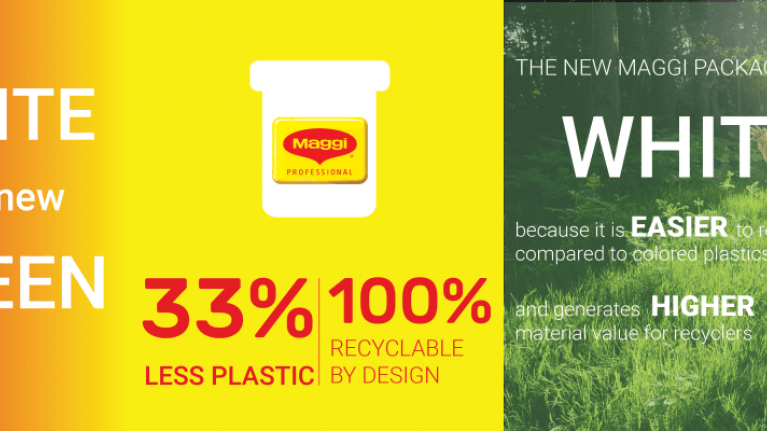
New Maggi Professional food services packaging is simpler to recycle
Nestlé Professional has recently redesigned its well-known Maggi Professional packaging from red and yellow to white.
The company is the first in the food services industry to change to white plastic packaging to make it easier for chefs, caterers, hotels and restaurants to contribute to the recycling process where infrastructures exist.
In addition, the new white Maggi Professional packaging is recyclable by design.
More value in white plastics
In the recycled materials market, white plastics are the preferred option because they can be dyed with greater flexibility in comparison to colored plastics, as highlighted by Tom Szaky, CEO for recycling company Terracycle and reusable packaging shopping system Loop1.
The lighter the plastic is, the better quality and the more material value it has for recycling companies.
New packaging is simpler to recycle
Maggi Professional’s new food service container packaging for European and Middle East markets is made out of polypropylene (PP), which is frequently used for everyday household products such as margarine tubs2. It is easy to handle and store in the kitchen.
The new white packaging – including container, lid and label – can all be placed into the recycling stream where recycling systems are available.
If there are no established systems in the area, they can team up with existing local recycling companies to set up a collection and recycling system, as another way to focus on sustainability in the kitchen.
All three sizes of the new Maggi Professional products, including the 1.2l, 1.6l, and 2.0l pack formats, are recyclable by design and contain a total of 33% less plastic, compared to the previous packaging.
As a result, Nestlé Professional’s food service plastic consumption in Europe is estimated to be cut by 131,000kg a year, in its first year of launch.
Improved and hygienic packaging for chefs
The new design has an improved tamper function that stays attached to the pack after opening, making it easier for chefs and cooks to recycle the whole container as one. This prevents smaller pieces of plastic littering the kitchen environment.
It has also been designed without a rim, eliminating any product build-up near the lid and making it more hygienic and less messy for chefs to use.
Nestlé has committed to reduce its use of virgin plastic by one third and aim for above 95% of plastic packaging will be designed for recycling by 2025, with the ambition of getting to 100% recyclable or reusable packaging.
Sources
1 Tom Szaky, 2015, The Many Challenges of Plastic Recycling: https://sustainablebrands.com/read/waste-not/the-many-challenges-of-plastic-recycling
2 Vicky Crowe, Which? How to recycle in the UK: https://www.which.co.uk/reviews/recycling/article/how-to-recycle-in-the-uk
3 Working towards a waste-free future, Nestlé Global: https://www.nestle.com/csv/global-initiatives/zero-environmental-impact/packaging-plastic-pollution